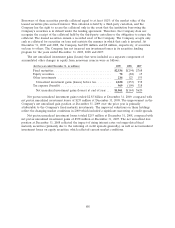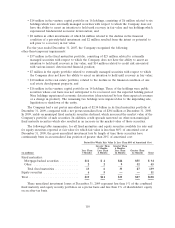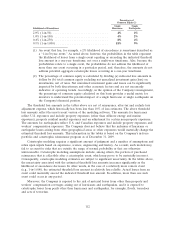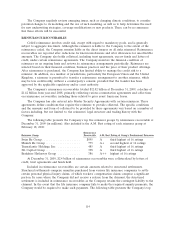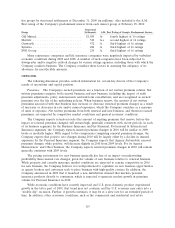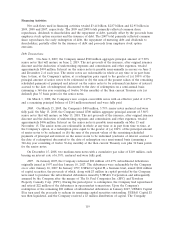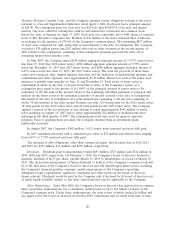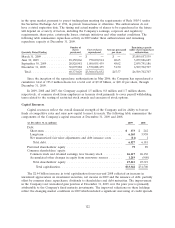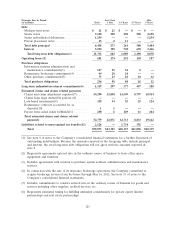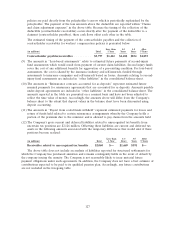Travelers 2009 Annual Report Download - page 129
Download and view the complete annual report
Please find page 129 of the 2009 Travelers annual report below. You can navigate through the pages in the report by either clicking on the pages listed below, or by using the keyword search tool below to find specific information within the annual report.interest rate movements, a rising interest rate environment would reduce the market value of fixed
maturity investments and, therefore, reduce shareholders’ equity, and a declining interest rate
environment would have the opposite effects.
Many of the statements in this ‘‘Outlook’’ section are forward-looking statements, which are
subject to risks and uncertainties that are often difficult to predict and beyond the Company’s control.
Actual results could differ materially from those expressed or implied by such forward-looking
statements. Further, such forward-looking statements speak only as of the date of this report and the
Company undertakes no obligation to update them. See ‘‘—Forward Looking Statements.’’ For a
discussion of potential risks and uncertainties that could impact the Company’s results of operations or
financial position, see ‘‘Item 1A—Risk Factors’’ and ‘‘Item 7—Management’s Discussion and Analysis
of Financial Condition and Results of Operations—Critical Accounting Estimates’’ in this report.
LIQUIDITY AND CAPITAL RESOURCES
Liquidity is a measure of a company’s ability to generate sufficient cash flows to meet the short-
and long-term cash requirements of its business operations. The liquidity requirements of the
Company’s business have been met primarily by funds generated from operations, asset maturities and
income received on investments. Cash provided from these sources is used primarily for claims and
claim adjustment expense payments and operating expenses. The timing and amount of catastrophe
claims are inherently unpredictable. Such claims increase liquidity requirements. The timing and
amount of reinsurance recoveries may be affected by reinsurer solvency and reinsurance coverage
disputes. Additionally, the variability of asbestos-related claim payments, as well as the volatility of
potential judgments and settlements arising out of litigation, may also result in increased liquidity
requirements. It is the opinion of the Company’s management that the Company’s future liquidity
needs will be adequately met from all of the above sources.
At December 31, 2009, total cash, short-term invested assets and other readily marketable
securities aggregating $2.14 billion were held at the holding company. The assets held at the holding
company are sufficient to meet the holding company’s current liquidity requirements and are almost
twice the Company’s target level. These liquidity requirements primarily include shareholder dividends
and debt service. The Company intends to reduce the amount of holding company liquidity in 2010,
subject to profitability, market conditions and other factors. The Company has a shelf registration with
the Securities and Exchange Commission which permits it to issue securities from time to time. The
Company also has a $1.0 billion line of credit facility with several financial institutions that expires in
the second quarter of 2010. This line of credit also backs up the Company’s $800 million commercial
paper program, of which $100 million was outstanding at December 31, 2009. The Company is not
reliant on its commercial paper program to meet its operating cash flow needs. The Company may
decide to replace the existing credit agreement with a new credit agreement of a different amount or
duration, or it could decide to replace the credit facility with other alternatives.
The Company currently utilizes uncollateralized letters of credit issued by major banks with an
aggregate limit of approximately $474 million to provide much of the capital needed to support its
operations at Lloyd’s. If uncollateralized letters of credit are not available at a reasonable price or at
all in the future, the Company can collateralize these letters of credit or may have to seek alternative
means of supporting its operations at Lloyd’s, which could include utilizing holding company funds on
hand.
Operating Activities
Net cash flows provided by operating activities totaled $4.23 billion, $3.14 billion and $5.29 billion
in 2009, 2008 and 2007, respectively. Cash flows in 2009 reflected a decline in catastrophe loss
payments, a higher level of reinsurance recoveries, a reduction in the amount of contributions to the
Company’s pension plan and lower claims and claim adjustment expense payments related to
operations in runoff. Those runoff payments in 2008 included the Company’s one-time net payment of
$365 million associated with the final settlement of asbestos claims related to ACandS, Inc. During
2009 and 2008, the Company contributed $260 million and $450 million, respectively, to its pension
plan.
117



